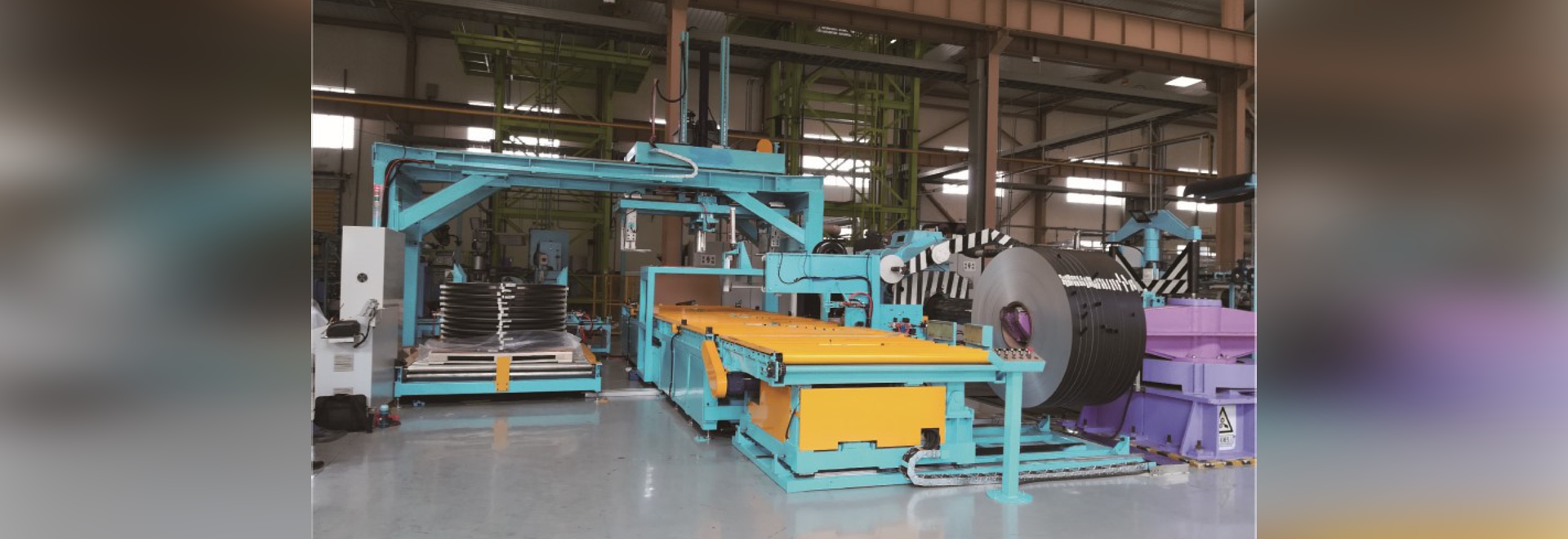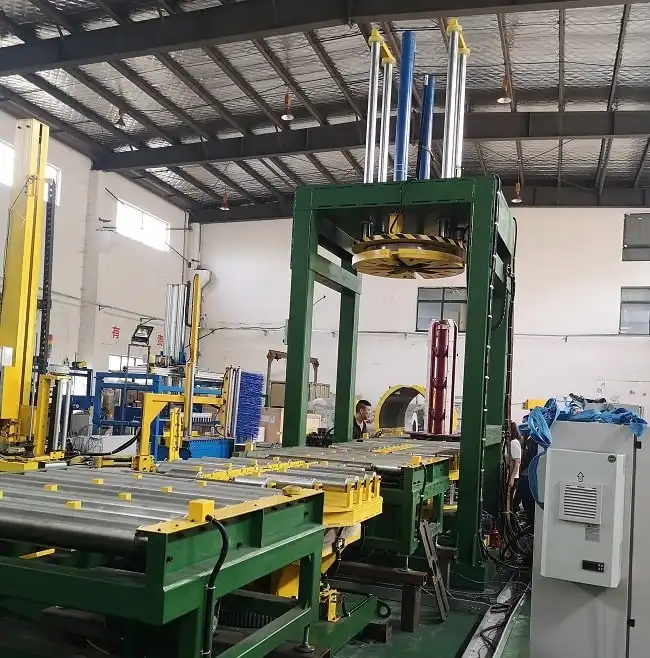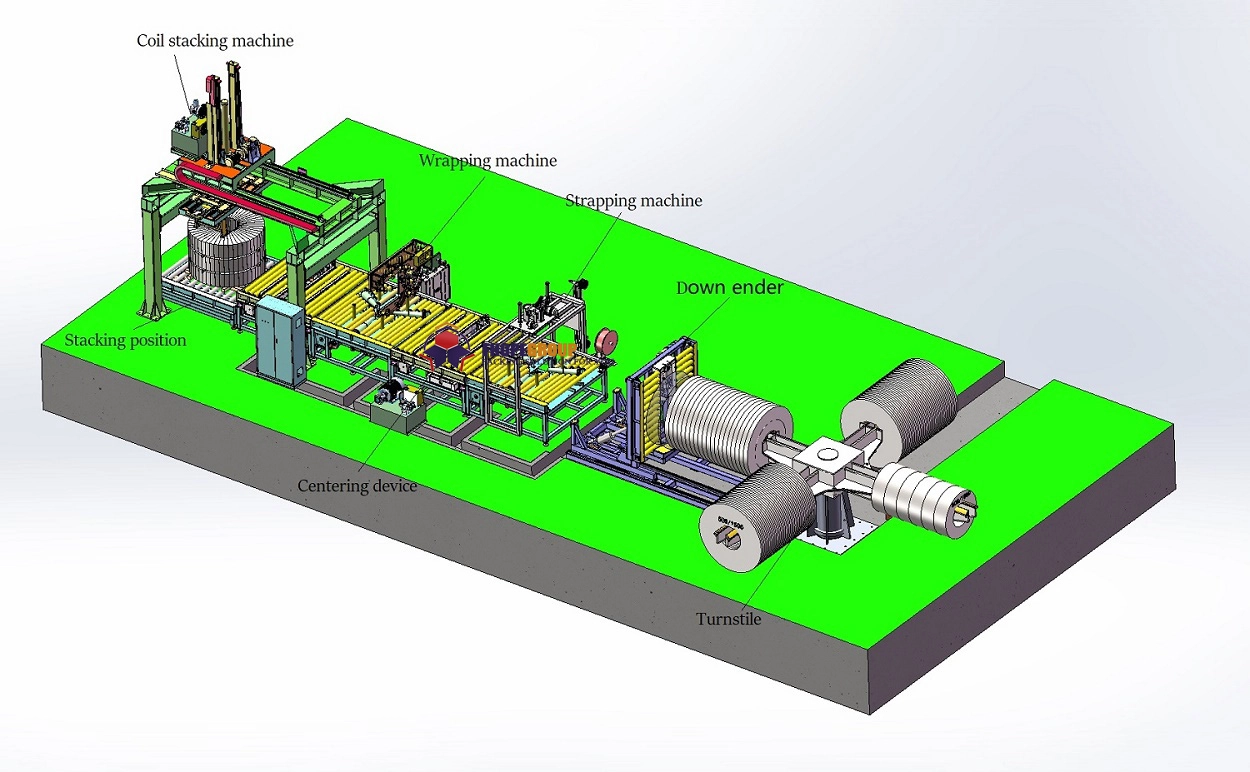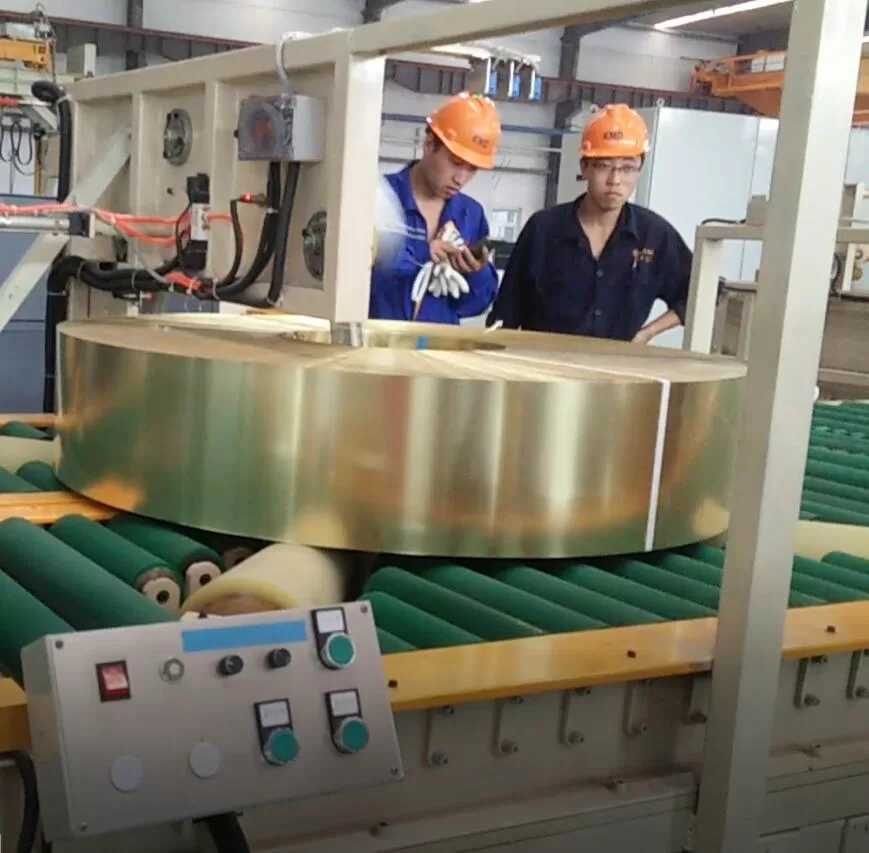Are you watching your operational costs climb while equipment reliability drops? Many steel plant owners I speak with are trapped in this cycle. They rely on aging packaging lines and manual labor, which leads to unpredictable downtime, inconsistent quality, and rising safety concerns. This old way of working eats into profits and makes it impossible to keep up with modern demands for efficiency and data. The pressure from fluctuating energy prices and stricter regulations only makes the problem worse, leaving managers wondering how they can possibly hit their production and financial targets.
U.S. steel plants are upgrading to automated coil packaging lines in 2025 to drastically cut operational costs, improve worker safety, and increase production throughput. These modern systems replace unreliable, labor-intensive processes with efficient, consistent, and data-rich automation. This solves key challenges like aging equipment, labor shortages, and the need for better process control, directly boosting the plant's overall profitability and competitiveness.

My name is Vincent Liu, and I’ve spent my entire career in the world of industrial packaging. I started on the factory floor, learning the machines hands-on. Later, I founded SHJLPACK to build the solutions I knew the industry needed. I’ve seen firsthand how the right equipment can transform a business. It’s not just about wrapping steel; it's about building a more resilient, efficient, and profitable operation. In this article, I want to share my experience and show you exactly why automation is no longer a luxury, but a necessity. We will look at the core challenges you face and see how a modern packaging line is the answer.
How Can Automated Packaging Lines Slash Rising Operational Costs?
You look at your monthly reports and see labor, material, and energy costs creeping up. A small jam on the packaging line causes a production bottleneck, leading to expensive overtime. A worker applies too much stretch film, wasting materials on every single coil. These small, hidden costs add up, slowly eroding your profit margins. You know there has to be a more efficient way, a system that gives you control and predictability over these expenses instead of constant surprises.
An automated packaging line directly slashes operational costs by minimizing manual labor, optimizing material usage, and running with high energy efficiency. The system automates repetitive tasks, reducing the need for a large packaging crew. It also applies wrapping materials with machine precision, eliminating the waste common in manual processes. This combination of reduced labor and material expenses provides a clear and rapid return on investment.

I want to dive deeper into how these savings happen. It's easy to say "automation saves money," but the real power is in understanding where those savings come from. When I work with clients like Javier, who scrutinize every investment, we break it down into tangible numbers. It’s not just one big saving; it's a collection of improvements across the board that create a major financial impact. Let's look at the three main areas: labor, materials, and maintenance.
The Labor Cost Equation
Manual packaging requires a team of workers for each shift. They handle strapping, wrapping, labeling, and moving heavy coils. This is not only expensive but also introduces human error and safety risks. An automated line can reduce the packaging crew by 70-80%. For example, a line that needed four people per shift might now only need one supervisor. This person oversees the system, manages material refills, and handles any exceptions. The rest of the work is done by the machine, 24/7, without breaks or shift changes. The savings in wages, benefits, and training are immediate and significant.
Precision Material Usage
In manual wrapping, consistency is almost impossible. One worker might use 1 kg of stretch film, while another on the next shift uses 1.5 kg for the same size coil. That extra 0.5 kg is pure waste, multiplied by hundreds of coils per day. An automated wrapper, however, is programmed for the exact number of layers and tension required. It uses the absolute minimum amount of material to achieve a secure, protective wrap every single time. This precision can cut your film and paper consumption by 20-30% or more. This is a direct, measurable saving that goes straight to your bottom line.
Comparing the Costs: Manual vs. Automated
Let's put this into a simple table. Imagine a plant packaging 200 coils per day.
| Cost Factor | Manual Packaging (Per Year) | Automated Packaging (Per Year) | Annual Savings |
|---|---|---|---|
| Labor | 4 Operators x 2 shifts x $50,000 | 1 Supervisor x 2 shifts x $65,000 | $270,000 |
| Material Waste | 25% waste rate on film/paper | <5% waste rate on film/paper | $50,000+ |
| Downtime Costs | ~10% unscheduled downtime | <2% unscheduled downtime | $100,000+ |
| Rework/Damage | 3% product damage rate | <0.5% product damage rate | $45,000+ |
| Total Estimated | High & Unpredictable | Low & Predictable | $465,000+ |
The numbers speak for themselves. The initial investment in automation pays for itself quickly, often in less than two years. After that, these savings become ongoing profit. This is how forward-thinking leaders like Javier justify the investment; it's a strategic move to secure the company's financial health for the long term.
Can Modern Packaging Systems Solve the Problem of Aging Equipment and Labor Shortages?
Your maintenance team is constantly patching up a 15-year-old strapping machine. The downtime is becoming more frequent, and finding spare parts is a nightmare. At the same time, your HR department tells you it's getting harder and harder to find reliable workers willing to do the physically demanding job of coil packaging. You are stuck between unreliable machines and a shrinking labor pool, and it's threatening your ability to meet production targets. This situation feels like a trap with no easy way out.
Yes, a modern, integrated packaging system is the definitive solution to the dual challenges of aging equipment and labor shortages. It replaces obsolete, failure-prone machinery with a brand new, reliable, and fully supported automated line. This immediately reduces maintenance headaches and unplanned downtime. By automating the entire process from coil receiving to final dispatch, it also drastically cuts the need for manual labor, making your operation resilient to workforce availability issues.

Let's break this down further. The problems of aging equipment and labor shortages are deeply connected. When a machine breaks down, you need skilled people to fix it. When you can't find people to run the machine, your production stops. A modern system addresses both sides of this coin. I remember a client who ran a steel wire facility. Their old compacting and strapping line was a constant source of stress. It would break down at least once a week, and only two older technicians in the whole plant knew how to fix its quirks. When one of them retired, it became a crisis. This is a common story. The solution isn't just a new machine; it's a new, more sustainable way of operating.
Escaping the Maintenance Trap
Old equipment operates on a reactive maintenance model. Something breaks, production stops, and you scramble to fix it. This is incredibly inefficient. A new automated line changes this in two ways.
- Inherent Reliability: New machines are built with modern components and are far more reliable. They come with warranties and full technical support from the manufacturer, like us at SHJLPACK. You're not hunting for obsolete parts on eBay.
- Predictive Maintenance: Modern lines are equipped with sensors (IoT) that monitor the health of motors, bearings, and other critical parts. This data allows you to move to a predictive maintenance model. The system can alert you before a component fails. You can then schedule maintenance during planned downtime, instead of having the machine fail in the middle of a critical production run. This is key to achieving a goal like 95% uptime.
Designing for a Smaller Workforce
A fully automated line is designed from the ground up to minimize human interaction. Let's trace a coil's journey:
- Entry: The coil is placed on an entry conveyor or turnstile by a crane or forklift.
- Centering & Weighing: The system automatically centers the coil, weighs it, and records the data.
- Wrapping: A robotic arm or orbital wrapper applies the protective layers with perfect consistency.
- Strapping: The strapping head automatically applies, tensions, and seals the straps at pre-programmed positions.
- Labeling: An automated printer-applicator creates and applies a detailed label with a barcode.
- Exit & Stacking: The finished coil is moved to an exit station, where it can be stacked or picked up for warehousing.
In this entire sequence, the operator's job is to supervise, not to perform manual labor. This makes the job safer, less physically demanding, and more appealing to a new generation of workers. It solves the labor shortage problem by redesigning the work itself. This also means your output is no longer limited by the number of people you can hire. The machine sets the pace.
What Role Does Automated Packaging Play in Meeting Stricter Environmental and Safety Standards?
You're facing increasing pressure from government agencies about environmental regulations. At the same time, you are deeply committed to the safety of your employees. Every time you see workers manually handling heavy coils or working near powerful strapping tools, you worry about the risk of accidents. You need a solution that not only ensures compliance with environmental rules but also creates a fundamentally safer workplace. The old methods are becoming a liability on both fronts.
Automated packaging lines play a crucial role in meeting stricter standards by directly addressing both environmental and safety concerns. They minimize material waste, which is good for the environment and your budget. More importantly, they remove workers from dangerous, repetitive tasks, drastically reducing the risk of injuries associated with manual handling of heavy steel coils. This creates a safer, more compliant, and more responsible operation.

From my experience building these systems, the safety and environmental benefits are not just a side effect; they are a core part of the value. When we design a line, we are thinking about more than just throughput. We are designing a system that protects people and minimizes its impact on the planet. Leaders like Javier understand that a strong safety record and good environmental stewardship are not just about compliance; they are essential parts of a modern, reputable brand. Let's look at how automation achieves this.
Building a Safer Workplace by Design
The most dangerous parts of a manual packaging process involve the interaction between a person and a heavy, powerful object. Think about the common risks:
- Strains and Sprains: Manually guiding wrapping material or lifting heavy tools.
- Crush Injuries: Getting hands or feet caught in machinery or under a shifting coil.
- Repetitive Motion Injuries: Performing the same strapping or wrapping action hundreds of times a day.
- Falls: Slipping on oil or debris around the packaging station.
Automation systematically eliminates these hazards. Robots and conveyors handle the heavy lifting. Automated wrappers and strappers perform the repetitive tasks. The human operator is moved to a control pulpit, separated from the moving machinery. This change in process design is the single most effective way to reduce workplace accidents in the packaging area. In my career, I've seen clients reduce their packaging-related safety incidents to nearly zero after installing a fully automated line.
Environmental Responsibility and Cost Savings
Environmental compliance often focuses on waste and energy. An automated line helps on both counts.
- Material Reduction: As we discussed earlier, machine precision cuts down on the overuse of wrapping film, paper, and plastic straps. This means less plastic and paper waste going to the landfill. It's a simple equation: less consumption equals less waste.
- Energy Efficiency: Modern motors and drives are significantly more energy-efficient than those from 15-20 years ago. A new line is designed as a cohesive system, where components work together efficiently. Some systems even feature regenerative braking on certain moving parts, which can recover energy. This helps you work toward goals like a 10% reduction in unit product energy consumption.
Here is how these two aspects compare:
| Feature | Manual/Old Line Impact | Automated Line Impact |
|---|---|---|
| Worker Safety | High risk of strain, crush, and repetitive injuries. | Worker is removed from hazardous tasks, risk is minimized. |
| Material Usage | Inconsistent and wasteful, high material consumption. | Precise and optimized, 20-30% less material used. |
| Energy Use | Inefficient old motors, high standby power consumption. | High-efficiency motors, smart power management. |
| Compliance | Constant risk of safety violations and excess waste. | Designed for safety compliance, reduces waste footprint. |
Investing in automation is a clear statement to your employees, customers, and regulators that you are serious about safety and environmental responsibility.
How Do Integrated Packaging Lines Help Steel Mills Achieve Digital Transformation Goals?
You see the power of data in other parts of your mill, like the smart scheduling platform you implemented. But the packaging area is a "black box." You don't know the exact status of a specific coil, how long it took to package, or what materials were used. This lack of visibility makes it impossible to truly optimize your entire production flow. Your goal is total production visualization, but your outdated packaging process is a major blind spot.
An integrated automated packaging line is a vital component of a steel mill's digital transformation. It acts as a key data collection point, connecting the physical world of production with your digital management systems like MES and ERP. By tracking every coil with sensors and barcodes, the line provides the real-time, granular data needed for full production visualization, predictive analytics, and process optimization.

This is where everything comes together. An automated line isn't just a machine; it's an intelligent node in your factory's network. For a forward-thinking owner like Javier, who wants to deploy MES and IoT platforms, the packaging line cannot be an afterthought. It must be part of that digital ecosystem. I've worked on projects where the integration of the packaging line was the final piece of the puzzle, unlocking a new level of control and insight for the entire plant.
From a Black Box to a Transparent Process
In a traditional setup, once a coil leaves the production line, it enters a manual packaging process where data is lost. You might know it entered the area at 10:00 AM and left at 11:30 AM, but you don't know what happened in between. An automated, integrated line changes this completely.
- Unique Identification: Each coil is identified by a barcode or RFID tag upon entry.
- Process Tracking: The system logs every step: when it was weighed, when wrapping started and ended, when strapping was completed, and what materials were used. All of this is time-stamped.
- Data Integration: This data is fed directly into your Manufacturing Execution System (MES). Your production planners can see the exact status of any order in real-time. Your quality team has a complete record of the packaging process for every coil. Your inventory system is updated automatically the moment a coil is finished.
Enabling Data-Driven Decisions
This new stream of data allows you to move beyond guessing and start making decisions based on facts.
- Performance Analysis: You can analyze the throughput of the packaging line, identify bottlenecks, and optimize the cycle time. For example, you might discover that changing the strapping pattern for a certain product type saves 30 seconds per coil.
- Quality Control: If a customer reports an issue with a damaged shipment, you can pull up the complete record for that specific coil. You can see the wrapping recipe used, check the strap tension data, and even review camera footage if the system includes it. This helps you pinpoint the root cause quickly.
- Predictive Maintenance: As mentioned before, sensors on the line monitor machine health. This data can be fed into a big data analysis platform. The platform can learn the normal operating parameters and predict failures before they happen, which is a cornerstone of achieving 95% or higher equipment uptime.
This digital connectivity transforms the packaging line from a simple cost center into a strategic asset that generates valuable information, helping you achieve your highest-level goals for efficiency and profitability.
Conclusion
Upgrading to an automated packaging line is a decisive move. It cuts costs, boosts safety, and provides the data you need to build a smarter, more resilient steel operation.




